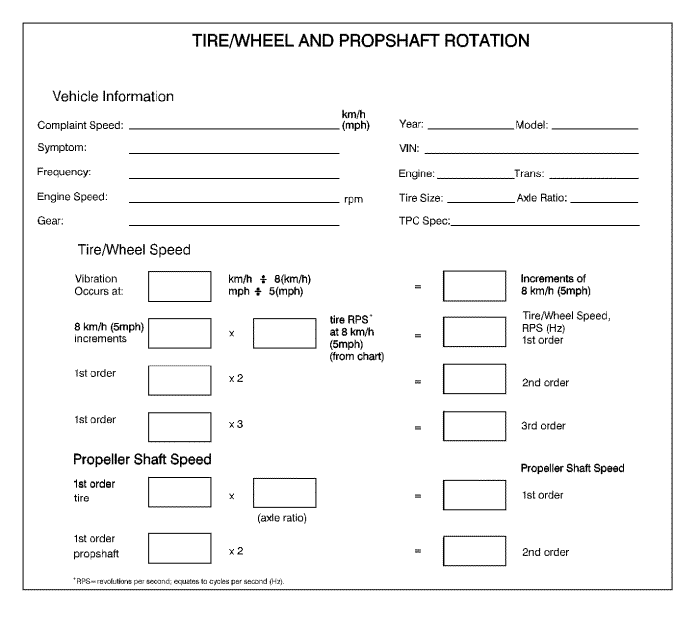Captiva |
||||||||
|
|
|
|||||||
EL-38792-A Electronic Vibration Analyser (EVA) 2
For equivalent regional tools, refer to Special Tools and Equipment .
Tyre and wheel assembly rotational speed can be obtained through using the EL-38792-A Electronic Vibration Analyser (EVA) 2 . Perform the following steps using the EL-38792-A Electronic Vibration Analyser (EVA) 2 to obtain the rotational speed at 8 km/h (5 mph). Use the Enter key to advance and the Exit key to backup.
For example: For a P275/55R20 tyre, enter 275.
For example: For a P275/55R20 tyre, enter 0.55.
For example: For a P275/55R20 tyre, enter 20.0.
For example: 275 0.55 20.0 - Front Wheel Drive. If the tyre size displayed is correct, press Enter.
For example: The P275/55R20 will display 0.90 RPS.
If the EL-38792-A Electronic Vibration Analyser (EVA) 2 is not available, the tyre and wheel assembly rotational speed can be calculated approximately by performing the following steps.
For example: For a P275/55R20 tyre, the rim diameter of 20 in X 2.54 converts to 50.80 cm.
For example: For a P275/55R20 tyre, the rim diameter of 20 in converted to 50.80 cm divided by 2 = rim radius 25.40 cm.
For example: For a P275/55R20 tyre, tread width 275 mm X aspect ratio as a decimal 0.55 = 151 mm X 0.93 = approximate sidewall height 140.43 mm.
For example: For a P275/55R20 tyre, approximate sidewall height 140.43 mm converts to 14.04 cm.
For example: For a P275/55R20 tyre, rim radius 25.40 cm + 14.04 cm = approximate tyre and wheel assembly radius 39.44 cm.
For example: For a P275/55R20 tyre, 6.283185 X approximate tyre and wheel assembly radius 39.44 cm = approximate tyre and wheel assembly circumference 247.809 cm.
For example: For a P275/55R20 tyre, 100,000 cm divided by approximate tyre and wheel assembly circumference 247.809 cm = approximate revolutions per kilometre 403.537.
For example: For a P275/55R20 tyre, approximate revolutions per kilometre 403.537 divided by the number of seconds to travel 1 km at a speed of 8 km per hour, 450 seconds = approximate RPS, or Hz 0.897 rounded to 0.90.
A size P235/75R15 tyre rotates ONE complete revolution per second (RPS), or 1 Hz, at a vehicle speed of 8 km/h (5 mph). This means that at 16 km/h (10 mph), the same tyre will make 2 complete revolutions in one second, 2 Hz, and so on.
For example: According to the Tyre Rotational Speed information, a P275/55R20 tyre makes 0.90 revolutions per second, or Hz at a vehicle speed of 8 km/h (5 mph). This means that for every increment of 8 km/h (5 mph) in vehicle speed, the tyre rotation increases by 0.90 revolutions per second, or Hz.
For example: Assume that a disturbance occurs at a vehicle speed of 96 km/h (60 mph). A speed of 96 km/h (60 mph) has 12 INCREMENTS of 8 km/h (5 mph):
96 km/h (60 mph) divided by 8 km/h (5 mph) = 12 increments
For example: To determine the tyre rotational speed at 96 km/h (60 mph), multiply the number of increments of 8 km/h (5 mph) by the revolutions per second, or Hz, for one increment:
12 (increments) X 0.90 Hz = 10.80 Hz, rounded to 11 Hz
Note: If the EL-38792-A Electronic Vibration Analyser (EVA) 2 is not available, compare the calculated rotational speed to the frequency range associated with the symptoms of the vibration concern. Refer to Symptoms - Vibration Diagnosis and Correction .
If the frequencies do not match, then the disturbance may be related to a higher order of tyre/wheel assembly rotation.
11 Hz X 2, for second order = 22 Hz second-order tyre/wheel assembly rotation related
11 Hz X 3, for third order = 33 Hz third-order tyre/wheel assembly rotation related
If any of these computations match the frequency of the disturbance, a disturbance of that particular order, relating to the rotation of the tyre/wheel assemblies and/or driveline components, also rotating at the same speed, is present.
11 Hz X 3.42 drive axle final drive ratio = 37.62 Hz, rounded to 38 Hz, first-order propeller shaft rotation related
If the frequencies do not match, then the disturbance may be related to the second-order of propeller shaft rotation.
38 Hz X 2, for second order = 76 Hz second-order propeller shaft rotation related
If the computation matches the frequency of the disturbance, a disturbance relating to the second-order rotation of the propeller shaft is present.
Utilise the following worksheet as an aid in calculating the first, second and third order of tyre/wheel assembly rotational speed and the first and second order of propeller shaft rotational speed related disturbances that may be present in the vehicle.
If after completing the Tyre/Wheel Rotation Worksheet, the frequencies calculated do NOT match the dominant frequency of the disturbance recorded during testing, either recheck the data, or attempt to rematch the figures allowing for 1½-8 km/h (1-5 mph) of speedometer error.
If the possible tyre/wheel assembly and/or propeller shaft rotational speed related frequencies still do not match the dominant frequency of the disturbance, the disturbance is most likely torque/load sensitive.
If after completing the Tyre/Wheel Rotation Worksheet, one of the frequencies calculated DOES match the dominant frequency of the disturbance, the disturbance is related to the rotation of that component group - tyre/wheel assembly or propeller shaft related.

| © Copyright Chevrolet. All rights reserved |